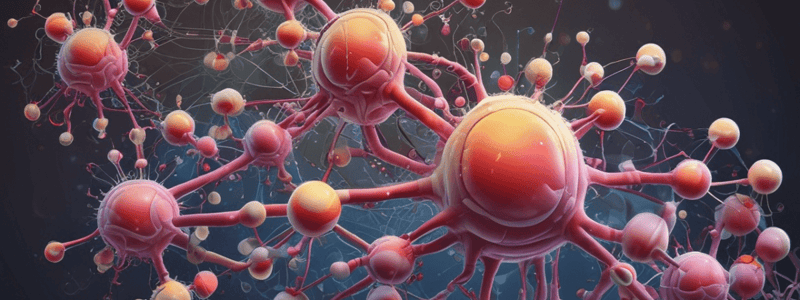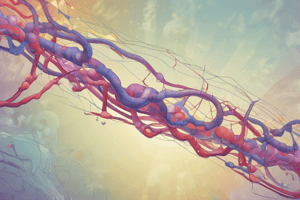Podcast
Questions and Answers
What is the primary function of thromboxane in the body?
What is the primary function of thromboxane in the body?
- Bronchoconstriction
- Vasodilation
- Leukocyte recruitment
- Platelet aggregation (correct)
Arachidonic acid is metabolized by two pathways: cyclooxygenase (COX) and lipoxygenase. Which of the following is a product of the COX pathway?
Arachidonic acid is metabolized by two pathways: cyclooxygenase (COX) and lipoxygenase. Which of the following is a product of the COX pathway?
- Interleukins
- Prostaglandins (correct)
- Nitric oxide
- Leukotrienes
Which of the following is NOT a pro-inflammatory interleukin?
Which of the following is NOT a pro-inflammatory interleukin?
- IL-1β
- IL-4
- IL-10 (correct)
- IL-6
What is the primary effect of nitric oxide in the body?
What is the primary effect of nitric oxide in the body?
What is the primary function of prostaglandins in the body?
What is the primary function of prostaglandins in the body?
What is the primary function of the mucociliary blanket in the respiratory tract?
What is the primary function of the mucociliary blanket in the respiratory tract?
Which of the following cells play a crucial role in the regulation of cellular changes during inflammation?
Which of the following cells play a crucial role in the regulation of cellular changes during inflammation?
Which of the following is a characteristic of chronic inflammation?
Which of the following is a characteristic of chronic inflammation?
What is the primary function of IgA secreted by mucous membranes in the gut?
What is the primary function of IgA secreted by mucous membranes in the gut?
Which of the following is NOT a function of the inflammation response?
Which of the following is NOT a function of the inflammation response?
What is the primary function of mast cells during inflammation?
What is the primary function of mast cells during inflammation?
Which of the following is a characteristic of the inflammation response?
Which of the following is a characteristic of the inflammation response?
What is the primary function of gastric acid in the gastrointestinal tract?
What is the primary function of gastric acid in the gastrointestinal tract?
Which of the following is NOT a component of the innate immunity in the gastrointestinal tract?
Which of the following is NOT a component of the innate immunity in the gastrointestinal tract?
What is the primary function of bradykinin in the inflammatory response?
What is the primary function of bradykinin in the inflammatory response?
What is the main function of clotting factors in the inflammatory response?
What is the main function of clotting factors in the inflammatory response?
What is the role of complement proteins in the inflammatory response?
What is the role of complement proteins in the inflammatory response?
What is the role of arachidonic acid metabolites in the inflammatory response?
What is the role of arachidonic acid metabolites in the inflammatory response?
Which of the following is NOT a function of complement proteins?
Which of the following is NOT a function of complement proteins?
Which of the following chemical mediators of inflammation is responsible for bronchodilation?
Which of the following chemical mediators of inflammation is responsible for bronchodilation?
Flashcards are hidden until you start studying
Study Notes
Arachidonic Acid Metabolites
- Arachidonic acid is a fatty acid present in the cell membrane
- Metabolized by two pathways: Cyclooxygenase (COX) and Lipoxygenase
- COX pathway produces:
- Prostaglandins (promote bronchoconstriction and vasodilation)
- Thromboxane (promotes platelet aggregation)
- Aspirin/NSAIDs block COX pathway
- Lipoxygenase pathway produces:
- Leukotrienes (promote bronchoconstriction and increase capillary permeability)
Chemical Mediators of Inflammation
- Interleukins (IL) and Tumor Necrosis Factor (TNF):
- Proteins produced by lymphocytes and macrophages
- Many kinds, some pro-inflammatory (IL-1β, IL-6), some anti-inflammatory (IL-4, IL-10)
- Many overlapping functions, including:
- Recruitment and activation of leukocytes
- Induction of acute-phase responses
- Interferons:
- Produced by virus-infected cells and lymphocytes
- Enhance defense against viruses by inhibiting DNA/RNA synthesis
- Some activate macrophages to destroy viruses
- Nitric oxide:
- Produced by endothelial cells
- Promotes smooth muscle relaxation and vasodilation
Types of Inflammation
- Acute inflammation:
- Early, short-term, and self-limiting
- Occurs before adaptive immunity can exert its effect
- Designed to remove injurious agent and limit extent of damage
- Neutrophils predominate in first 24 hours
- Chronic inflammation:
- Late, long-term, and self-perpetuating
- Usually the result of recurrent inflammation/irritation or slow processes that fail to induce an acute response
- Macrophages and lymphocytes are more common
Acute Inflammation: Vascular Response
- Following tissue injury:
- Clear pathogens and debris from injured tissue/wounds
- Coordinate vascular and cellular aspects of inflammation
- Tightly regulated with lots of checks and balances
Chemical Mediators of Inflammation
- Histamine:
- First inflammatory mediator released
- Produced by mast cells
- Responsible for:
- Vasodilation
- Increased vascular permeability
- Bronchoconstriction
- Temporary, with leukotrienes taking over once synthesized
- Bradykinin:
- Initiated by activation of Hageman factor (factor XII)
- Responsible for:
- Vasodilation
- Increased vascular permeability
- Bronchoconstriction
- Pain
- Clotting factors:
- Produced by liver
- Induce the clotting cascade
- Lead to production of fibrin clot
- Complement proteins:
- Plasma proteins
- Present in inactive form
- As part of inflammation:
- Increase vascular permeability
- Promote chemotaxis
- As part of immune system:
- Act as opsonins and facilitate phagocytosis
- Create holes in cell membrane of pathogens (membrane attack complex - MAC)
Innate Immunity: The Gastrointestinal Tract
- Gastrointestinal tract:
- Most pathogens are transported via food contaminated with fecal material
- Gastric acid destroys pathogens in stomach
- Viscous mucous layer coats gut and entraps microbes
- Pancreatic enzymes and bile detergents destroy organisms
- IgA secreted by mucous membranes in gut
- Normal bacterial flora compete with pathogens for nutrients
Inflammation
- SECOND LINE OF DEFENSE
- Programmed response to tissue injury
- Integrated system of humoral and cellular responses designed to:
- Limit tissue damage
- Destroy pathogens
- Initiate adaptive immune system
- Begin healing
- Rapid response in vascularized tissue (begins in seconds)
Cells of Inflammation
- Endothelial cells:
- Layer of cells lining blood vessels
- Release nitric oxide (NO) to promote vasodilation
- Release inflammatory mediators (interleukins, prostaglandins, etc.) to regulate cellular changes during inflammation
- Control movement of cells through endothelial layer
- Release tissue factor in response to injury (activates extrinsic pathway of clotting cascade)
- Mast cells:
- Cells that lie in connective tissue near blood vessels
- When activated, mast cells:
- Degranulate (release inflammatory mediators stored in cellular granules)
- Immediate response, primarily histamine
Studying That Suits You
Use AI to generate personalized quizzes and flashcards to suit your learning preferences.


